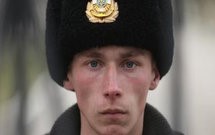 Kiev ordered a military mobilization and called up reservists nationwide March 2, a day after Russia's upper house of parliament approved Russian President Vladimir Putin's request to send troops into Ukraine. But the Ukrainian military finds itself in a weak state of readiness at a time when its country needs it the most. That and Western reluctance to get involved militarily will make Kiev hesitant to provoke the Russians by using military force.
Kiev ordered a military mobilization and called up reservists nationwide March 2, a day after Russia's upper house of parliament approved Russian President Vladimir Putin's request to send troops into Ukraine. But the Ukrainian military finds itself in a weak state of readiness at a time when its country needs it the most. That and Western reluctance to get involved militarily will make Kiev hesitant to provoke the Russians by using military force.
At first glance, the Ukrainian military appears quite capable. Though largely equipped with legacy systems from the late Cold War, the weapons -- whether tanks, combat aircraft, or helicopters -- in Ukraine's inventory remain potent. In fact, the Russians continue to use much of the same equipment despite a recent modernization drive. On paper at least, the Ukrainian armed forces have a few hundred combat aircraft, a number of relatively advanced surface-to-air missile batteries, thousands of armored fighting vehicles and a large inventory of self-propelled and rocket artillery. Ukraine also benefits from a nominal standing army of approximately 150,000 troops, 1 million more in reserve and a large pool of people fit for military service within the wider population. Finally, Ukraine has already successfully transitioned to a more flexible brigade structure, and has increasingly benefited from joint training exercises with NATO.
In reality, however, Ukraine's military suffers from a number of key structural weaknesses that severely undermine its nominal strength. First of all, a large portion of Ukraine's military equipment is either in storage or inadequately maintained. For instance, photos of the 204th Tactical Aviation Brigade stationed in the dual civilian-military airport of Belbek, which the Russians recently seized, show numerous mothballed fighter aircraft unfit for immediate service. Similarly, the majority of Ukraine's tanks are known to be in long-term storage. With a modest annual military budget of approximately $2 billion, Ukraine could not hope to adequately maintain its oversized equipment inventory. Training for much of the regular units in Ukraine has also reportedly been limited due to a lack of funding.
Moreover, Ukraine's military currently is widely dispersed, and mobilization at a time of political crisis and wide-scale domestic opposition is difficult, to say the least. Even if the bulk of Ukraine's conventional army is in the center and the west, a number of its key units are based close to Russia in the east and far from the core concentration of Ukraine's forces. Ukraine would also likely have to deal with transportation bottlenecks, sabotage and -- as seen in Crimea -- disruption attempts by pro-Russian forces, such as those that blocked critical causeways into the peninsula. The dispersed nature of the potential threat complicates matters for Ukrainian planners. Russia has military elements in Crimea to the south and exercising along portions of Ukraine's eastern border, while to the north is Belarus, a staunch Russian ally that cannot be ignored.
Furthermore, unlike the small and militarily very weak Baltic states that also must contend with Russia, Ukraine does not benefit from a military alliance system that it can rely on against Russia. As during the 2008 Georgia war, NATO and the United States are very unlikely to intervene militarily on the side of a non-member state against a Russian Federation that still maintains thousands of nuclear weapons. From the point of view of Western capitals, the dangers of escalation and the associated costs simply do not justify the minimal strategic gain intervention would yield.
Finally, Kiev's greatest weakness is the polarized nature of Ukrainian society, and by extension the Ukrainian military. The transitional government in Kiev understands that it cannot fully rely on the loyalty of the armed forces, so sending them into conventional battle against the Russians would risk substantial defections. Indeed, Ukraine's military leadership has seen a number of changes over the last month, highlighting the lack of dependability even at its highest echelons.
Both Russia and Ukraine have largely attempted to minimize bloodshed during the crisis. Despite highly provocative actions, the Russians repeatedly have sought to disarm Ukrainian forces without exchanging gunfire, while the Ukrainians in turn have largely ceded Crimea without a fight. A conventional war is something that both Russia and Ukraine strongly want to avoid. Ukraine's current military weakness and the West's limited appetite to escalate militarily will be major factors in Moscow's decision, and ability, to employ its military in pursuit of its goals in Ukraine.
Courtesy : Stratfor (www.stratfor.com)